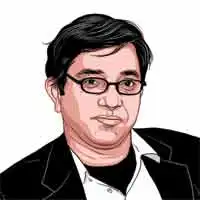The BJP’s attack on Rahul Gandhi, including his parliamentary disqualification, has two dimensions: The conjunctural and the structural. The conjunctural issue is simply this. In a webinar at Brown University on March 16, 2021, moderated by me, and another at Harvard shortly thereafter (April 2), chaired by Ambassador Nicholas Burns, Rahul’s arguments about the threats to Indian democracy were the same as at Cambridge University earlier this month. The latter led to an unending BJP chorus for an apology from Rahul; the former did not. What has changed? Rahul’s Bharat Jodo Yatra and/or his parliamentary questioning of the allegedly collusive Modi-Adani links constitute the best hypothesis.
But the primary purpose of this column is structural. For some time now, I have taken the position that India is still an electoral democracy, though it has been declining as a liberal democracy. I have often been asked how long this double life — electoral fervour with liberal decline — can continue. Sweden’s V-Dem Institute, widely noted, has already been calling India an “electoral autocracy”. I have thus far disagreed and I still believe that an electoral autocracy is not a certain denouement, but the events are going in that direction.
The larger debate about Indian democracy is linked to two underlying questions. Why is the distinction between electoral and liberal democracy maintained? And why is the distinction now beginning to disappear?
Conceptually, democratic theory distinguishes the electoral from the liberal. The electoral dimension is about whether elections are free and fair, and whether all adult citizens can vote. “No elections, no democracy” is a widely accepted dictum. But that is only the minimal definition. The liberal dimension is about broader requirements, which not only include elections but also cover what happens between elections.
For democracy to be meaningful between elections, a polity must allow its citizens at least four “civil liberties” and one significant “safeguard”. The four liberties are: Freedom of expression, freedom of association (non-state organisations or what is termed “civil society”), freedom of religion, and freedom to move. The final requirement is minority safeguards, an idea that appeared strongly only after the Second World War. In the inter-war Continental Europe, minorities were hounded and millions killed. It was even claimed that if the majority community so wished, discrimination as well as violence against minorities did not fundamentally violate the principle of popular will. After 1945, it became clear to political thinkers and statesmen that while democracy was indeed based on majority rule, this principle could not be allowed to legitimate majoritarian hatred and violence. A democracy without minority rights could easily become an instrument of majoritarian oppression. Minority rights thus became sacrosanct. It was also recognised that the judiciary, not technically under majoritarian pressures, was the best institution to protect civil liberties and minority rights.
In India, such liberalism never received the full adherence of politicians and society, but the erosion since 2014 has been unmistakably severe. Combining state and societal action, an attack on Muslim minority rights commenced with Dadri and other lynchings as early as 2015; continued through “love jihad”, anti-beef and anti-hijab campaigns; acquired discriminatory legal form with the Citizenship Amendment Act (2019), which made Indian citizenship unavailable to Muslim refugees from the neighbourhood, allowing all others; and culminated in the bulldozer campaigns, mostly against Muslim businesses and properties. Freedom of expression was increasingly curtailed for writers, journalists, academics and artists. And civil society was undermined. In November 2021, India’s national security advisor openly argued that civil society was the next frontier of war.
Paradoxically, while all of this was going on, elections remained vigorously contested. Doubts have been expressed about whether the Election Commission and/or the new electoral bonds have tilted the scales in favour of the BJP. But even if they have, and there is reason to believe that may be true, they haven’t done so in a way that has fundamentally altered election results. From the viewpoint of democratic theory, the best evidence in favour of this claim is that even today, 12 out of 28 Indian states have non-BJP governments, including West Bengal and Delhi, which Prime Minister Modi badly wanted to win but could not.
The next elections may no longer allow this double script to continue. Bad as it was, Delhi’s ire is no longer confined to dissenting artists, intellectuals, writers, minorities and civil society organisations. Now, the leaders of the Opposition are also in the line of fire. The onslaught takes the form of criminal probes by investigation agencies and/or the filing of criminal cases by the regime or its supporters, even as cases are dropped against those Opposition leaders who join the BJP. The famous Latin American proverb — “for my friends, everything; for my enemies, the law” — now has an Indian incarnation.
All modern polities have agencies to investigate violation of laws by politicians and bureaucrats. Moreover, India’s rulers, since the 1970s, have often used these agencies in a partisan manner. But the scale is now astronomically different. As this newspaper noted in an editorial (‘Arresting Mr Sisodia’, IE, February 28), “of the 124 prominent politicians who had been under CBI probe since (2014), as many as 118 … are from the Opposition — a staggering 95 per cent, up from 60 per cent during the UPA years.” This was as of September 2022. Since then, the skewing has become worse.
The barely concealed aim of this thrust is to weaken non-BJP parties — by jailing their popular leaders, or by creating a climate of fear. As a result, the 2024 elections may not be free. In control of state power in Delhi and having immeasurable resources, an all-powerful BJP may face emaciated Opposition parties, radically diminishing electoral contestation. Such diminution will undermine the electoral democracy claim.
Of course, this upshot is not cast in stone. At least two variables are critical. Will the Opposition parties — given that all are now mortally threatened, or will be in the next five years — fight the BJP in a united manner? And will the courts demonstrate their constitutional independence, not display craven subservience to the ruling regime? Indeed, since the Emergency, the role of courts has never been as significant. India’s democracy is teetering on the edge.
The writer is Sol Goldman Professor of International Studies and the Social Sciences at Brown University and contributing editor, The Indian Express
Misogyny in the matrimonial market: Data shows Indian men prefer wives without jobs

 Ashutosh VarshneyThe writer is Sol Goldman Professor of International Studies and the S… read more
Ashutosh VarshneyThe writer is Sol Goldman Professor of International Studies and the S… read more

